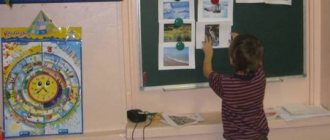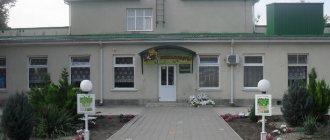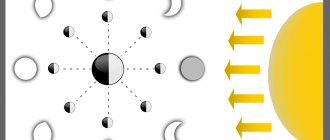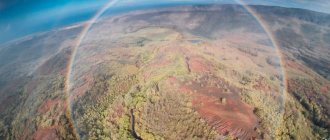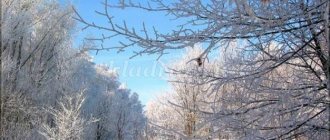- Reports and messages
- Animals
- About the red book
Red is the color of anxiety and at the same time the desire for life.
It lists representatives of the animal and plant world: rare ones and those that are in danger of extinction. Back in 1902, the International Convention for the Conservation of Birds was signed in Paris - the predecessor of the modern Red Book. And in 1928 the idea of such a publication was voiced.
In 1963, the International Union for Conservation of Nature published the first International Red Book, listing mammals and birds. They published it in two volumes, designed like a calendar with a red cover, the pages of which can be thrown over. The book was distributed by mail.
The second publication, now with a list of reptiles, also in a modest circulation, was published from 1966 to 1971.
The third publication was published in mass circulation, the book has already been sold.
The fourth publication was published between 1978 and 1980. There is no newer edition yet.
The International Red Book is not a mandatory document.
The first Red Book of the USSR was published in 1978. In its two parts, only vertebrate land animals, birds, amphibians and reptiles are named. The list of plants is presented in the second volume. Essentially, this publication is a program for the conservation and rescue of endangered species.
The next publication, 1984, is also a two-volume, but significantly expanded edition. Lists of fish, arthropods, mollusks and annelids are included for the first time.
In 2001, the Red Book of the Russian Federation was published. It has 860 pages, the publication contains color illustrations and habitat diagrams. Along with invertebrates, this publication lists 434 taxa, that is, groups of organisms that have some commonality. The book has the force of an official document. Each subject of the federation develops its own based on it. In 2015, the Red Book of the Republic of Crimea was published.
The Red Book is intended to draw people's attention to the decline in species of flora and fauna, characterize these species and promote their renewal.
Many countries in Europe, Central and Southeast Asia, the USA, Australia, and Japan have similar publications.
There are also the Red Book of the World and red lists. Their purpose is the same: to convey information about species that are at risk of extinction. In addition to these books and lists, there is also the Green Book (a list of rare typical plant groups) and the Black Book (a list of species that became extinct after 1500).
From the pages of a textbook
This project work completes a large section of the textbook called “Nature”. And the “red book” is the name of one of the paragraphs of this section.
Let's see what is required of us?
ABOUT! Our good friends are Seryozha and Nadya, inquisitive inhabitants of the textbook. They did something again. Or rather, they did. This time the guys came up with their own Red Book. They placed insects, plants, and animals on her pages. And our children are encouraged to do the same.
That is, you need not to repeat the real, really existing Red Book, but to make your own. It turns out that you can add into it not only those animals and plants that are already under protection, but also any others you want. Well, this expands our capabilities.
In what form should the project be presented? It seems like they are asking to make a Red Book. And the Red Book is, strictly speaking, a book.
But! In the workbook, space is also reserved for this project. This means that it can be done in a notebook.
Let's start with it.
Popular message topics
- Springs
Under the ground there are many voids that are filled with water. It flows there from the surface of the land after rain or melting snow. The waters are at different depths and have different volumes. It is because of these accumulations that springs are formed. - Strawberries
are a tasty, sweet, bright and slightly sour berry that is loved by both children and adults. Nowadays it is a fairly common product on the world market. - Drought Drought
is a long-term lack of precipitation and an increase in air temperature, which is accompanied by a decrease in soil moisture and leads to the loss of crops in agriculture, the occurrence of forest fires, and the ignition of peat bogs.
Project protection
What does it mean to protect a project? This means giving a short presentation of your work in front of the class. Pick up (in this case) a notebook, go to the board, speak briefly on the topic of work, adhering to a pre-planned plan.
The main thing is not to go too deep. 5 minutes is the maximum maximum! There are many people who are passionate about, as well as those who are forced to))) defend their work in the classroom. So save your time. The lesson, as they say, is not rubber-stamp.
The hardest thing is to start. Why? And from the definition of the Red Book, which is already written in the workbook. This will be a great short introduction that will easily flow into the first point of our plan.
In practice it might look like this:

Great! A start! The first point of the plan has been completed. Let's try to move on to the second, which involves telling a story about the benefits that the “residents” of the project bring.

There are 12 “inhabitants” in our book. There is no need to talk about everything during the presentation. Four will be enough.
But! It is necessary to know about the benefits of the remaining eight. Don’t forget that defending a project involves answering questions from listeners. One of your classmates may ask about the benefits of a specimen not mentioned in the presentation. So, be prepared for this.
Well, we still have the final point of the plan about ways to protect animals and plants.
If you think about it, it turns out that the methods of protection are universal for all representatives of ours, and any other Red Book.
- Do not kill (do not pull out, do not trample, do not chop if we are talking about plants).
- Help in difficult times (for example, feed or treat).
- Do not pollute, take care of nature (do not litter, do not burn fires in forests, do not dump waste into rivers and lakes, install treatment facilities on factory pipes, etc.)
- Restore (plant trees, go to cleanup days, etc.)
It is clear that a child will not go to a factory and install a modern filter on a pipe. But he is quite capable of not picking a flower, not breaking a tree, not killing a beetle, not throwing a candy wrapper past the trash can.
Well, we figured out how to make a project in a workbook and how it can be presented.
Let's move on to the next, more creative way of designing this work. We will make a real Red Book. Although, rather not a book, but a book that you can bring to school in your pocket.
Report on the Red Book
We all know that on our planet, along with humans, other representatives of nature live next door. Human greed, manifested in deforestation and drainage of water bodies, became the impetus for many species of flora and fauna to cease to exist. Since ancient times, people have enriched themselves at the expense of others; skins and meat were obtained from animals, and wood from trees. Many animals died in the forests, and valuable bushes and trees were destroyed. Humanity was afraid of the consequences of its activities, so a special world commission decided to create a special book, which included all endangered species. This book was given the name Red Book. It is the red color that should signal the danger caused by humans to nature and its inhabitants. We just have to think that the species described here are either completely extinct or will soon be gone. People themselves destroyed what nature took a long time to create and carefully preserve. Each country in the world has its own special representatives of fauna and flora, which need protection every day.
The Red Book is a document that records exact data about the value and way of life of each representative of plants and animals inhabiting our Planet. The Red Book includes several pages, each of which has a different color and meaning.
- Black pages are where data about animals that have become extinct is collected.
- Red pages - store information about all gradually disappearing or rare species of plants and animals.
- The Yellow Pages will tell curious readers about animals that are becoming smaller every year.
- White pages - they contain information about all those who were not many in nature anyway.
- Gray pages - include the number of individuals living in places where people can hardly reach.
That is why such animals are difficult to study, and little is known about them. Perhaps, thanks to their habitat, they were able to survive to this day.
Green Pages have become a haven, on paper, for all the animals that have already been saved from extinction.
Plants and trees are also worthy candidates for the Red Book. In many countries, and especially in Sri Lanka, the exotic plant Kadupul flower grows. It is unique in that its flowering can be seen very rarely, and when the flower does bloom, it quickly dies. In the Bahrain desert, scientists discovered a tree of life that, after standing for 400 years without moisture, was able to remain green to this day. The Methuselah pine grows in the United States and is approximately 5,000 years old. Its location is completely hidden, since it is in a single copy. The favorite food of bats is the jade vine. This flower has long been considered an endangered species, this is directly related to the destruction of the forests where the flower grows. This is just a small part of the examples that a person is simply obliged to protect for future generations.
Many representatives of nature, which over time cease to need protection and protection, are rewritten to other pages in the book. It is very encouraging that, despite the great catastrophe of extinction, many species can still be saved. The Red Book itself is a document with temporary data. Over the years, people discover and find unique and interesting species, they naturally include them in the Red Book, work on changes to which continues to be completed today. Not only the number of individuals changes, their living conditions and habitat also change. Nowadays, people are still trying to preserve endangered species more than to harm them, all this is very pleasing. Nature is not only the home for all living plants and animals, it is also our common home, the home of man. Therefore, everything should be done to preserve our nature as it is, and to help many species find a place in it, be it a small mosquito or a large crocodile.
2nd, 3rd, 4th, 5th grade, the world around us
Fish
As a result of intensive fishing, fish numbers have decreased significantly since the second half of the 20th century. Additional negative factors include an increase in the number of ships, pollution, and the extraction of building materials.
Atlantic sturgeon
The largest species in the sturgeon family. Found in the waters of the Black and Baltic Seas. The basis of the diet is smaller species of fish. Sturgeon was considered rare back in the 20th century, and is currently on the verge of extinction due to intensive fishing. Isolated cases of catching are known. It is impossible to reproduce the species artificially.
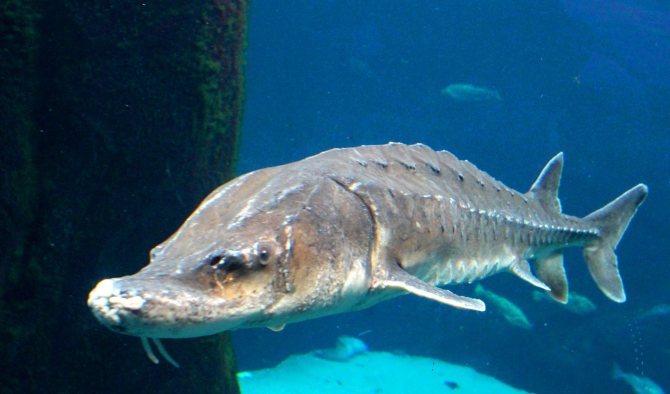
Atlantic sturgeon
Beluga
Previously, beluga was considered a valuable commercial fish, but now the species is classified as endangered. Fishing has been banned in the country since 2000. Active fishing, hydraulic construction, and poor reproduction of the species are the main factors in reducing the population size.
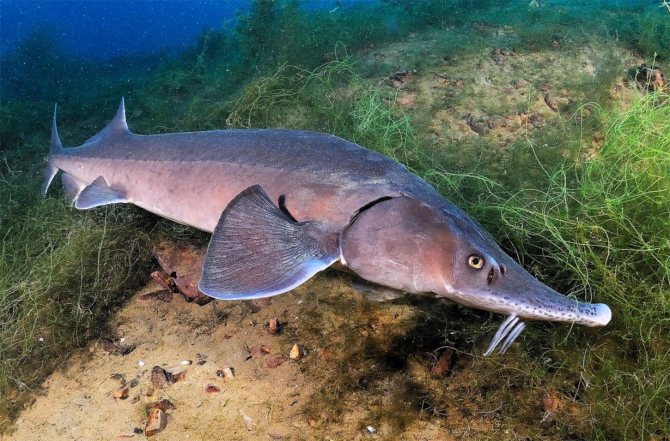
Beluga
Belugas are predators and are considered the largest representatives of freshwater fish.
Interesting fact : the largest beluga weighed 1224 kg or 1.2 tons. At the same time, the weight of the torso was 667 kg, the head – 288 kg, and the calves – 146.5 kg.
Sterlet
Sturgeon fish, sterlet, is found in rivers such as the Kama, Dnieper, Kuban, Ural and Don. It feeds on fish eggs and invertebrates living on the bottom. According to its conservation status, sterlet is a vulnerable species.
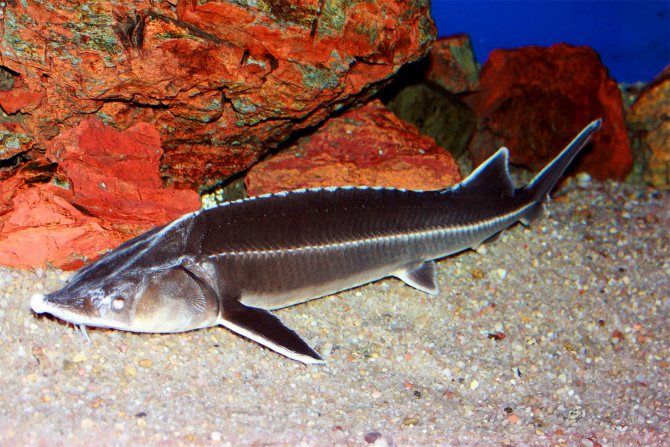
Sterlet
Population numbers are declining for several reasons: water pollution, poaching, and shallowing of water bodies. In addition, reservoirs and hydroelectric power stations are built on rivers, which interfere with water purification and also prevent fish from getting from the sea to the river, where they tend to spawn.
Brown trout
Trout is a fish of the salmon family, which is represented by several subspecies. In Russia, depending on the species, it is found in the waters of the Baltic Sea, lakes of Karelia, and in rivers in the Leningrad, Tver, Novgorod and other regions.
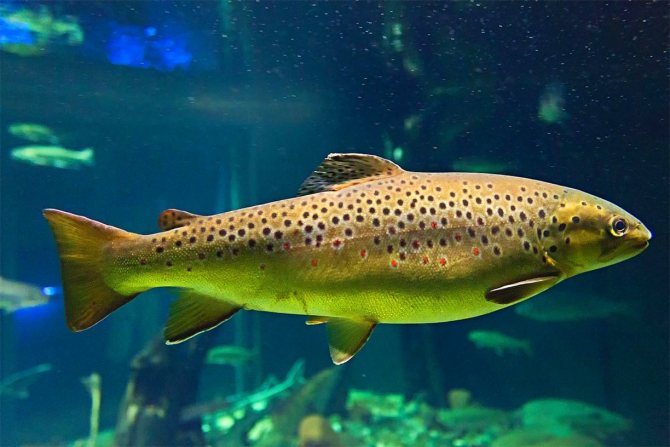
Brown trout
Currently, the number of brown trout is rapidly declining, and in some reservoirs the fish have completely disappeared. The main reasons are water pollution, construction of hydroelectric power stations, and illegal fishing.
Chinese grouper
Perch is found in the Ussuri and Amur rivers, in the northwestern part of Sakhalin, in Lake Khanka. It feeds on smaller fish and insufficient food is included in the list of main factors in population decline. It is also subject to mass fishing and suffers from environmental pollution.
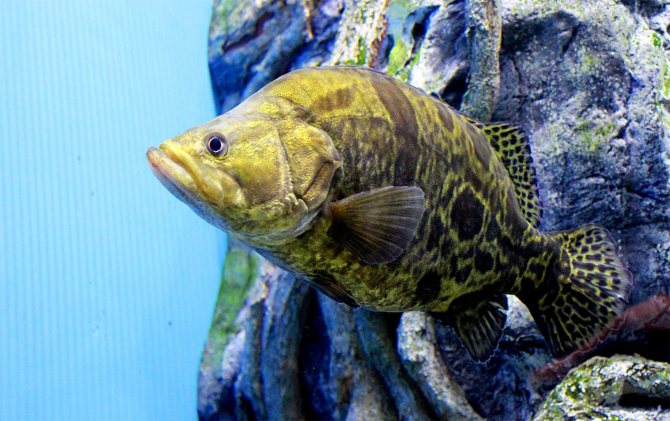
Chinese grouper
Birds
The large territory of the country is conducive to the settlement of various natural areas by all kinds of birds. About 100 species are listed in the KKRF. Many of them are common in national parks, game reserves and nature reserves.
black crane
Most black cranes nest in the country. The birds form several populations, whose habitats extend from the Central Siberian Plateau to the Sikhote-Alin.
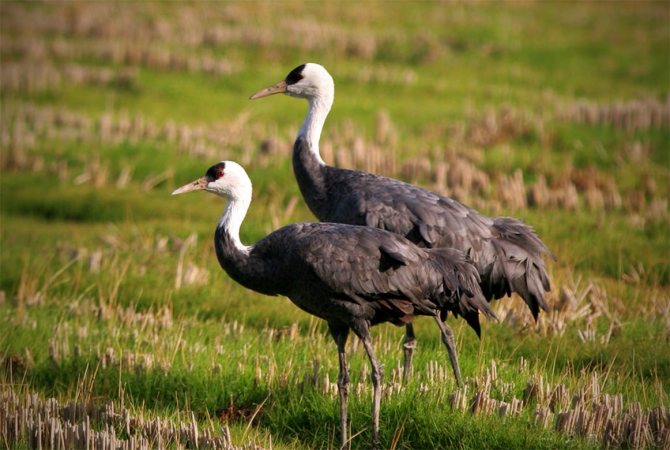
black crane
The number of black cranes around the world is about 11,000. They feed on a variety of foods - both animal and plant foods. They prefer swampy areas and woody vegetation.
The population of black cranes is most actively threatened by human economic activities in the habitat areas of these birds. They migrate to Japan, where living conditions are quite good, but epidemics occur regularly.
Interesting fact : the black crane is the least studied among its relatives. The species was discovered only in 1974.
Siberian Crane
The Siberian Crane (white crane) is distributed exclusively in Russia, and in the form of two separate populations - eastern and western. They are very demanding of living conditions and prefer an aquatic lifestyle. Because of this, maintaining the appearance is quite difficult. The number of West Siberian Siberian Cranes is 20 individuals, and the total number in the world is up to 3000.
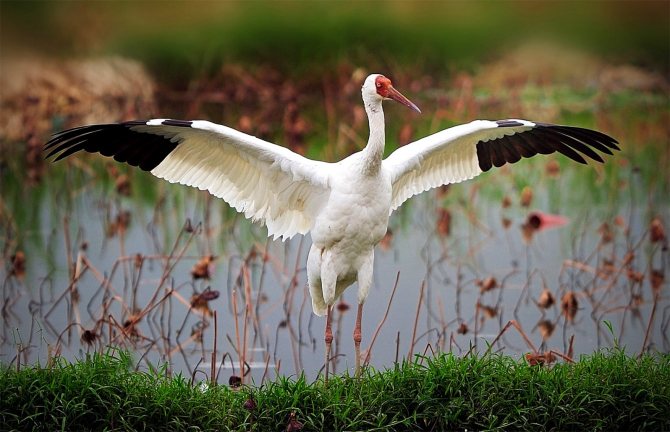
Siberian Crane
Difficulties also arise during migrations. The birds head to China, where the areas are too urbanized - the swamps are dried up, the land is used for agriculture. In order to preserve the population, ornithologists from different countries, including the Russian Federation, are working together on the special project “Sterkh” - they are looking for new ways to restore the number of birds.
Steppe Harrier
The steppe harrier is a relatively small migratory bird. Distributed in Central Asia and Eastern Europe. Belongs to the predators. Prefers natural areas such as steppe, forest-steppe and semi-deserts.
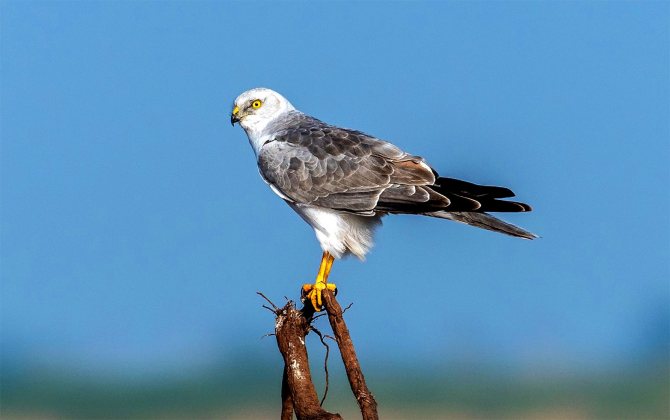
Steppe Harrier
Birds often move within their range, so it is difficult to determine their numbers in the Russian Federation. The number of individuals in the world is about 40 thousand. The species is considered rare and endangered.
Steppe harriers have several natural enemies (eagles, imperial birds). Also, significant damage to their habitats is caused by human influence - the destruction of vegetation in meadows and thickets of bushes in the steppe. The total number of birds in Russia is about 5000.
White seagull
Ivory gulls make nests on the sea coasts of the Arctic Ocean. The only representatives of their kind. The exact number of individuals has not been established, as have the reasons for the decline in the species. Currently, the ivory gull is at low risk of extinction, but still needs protection.
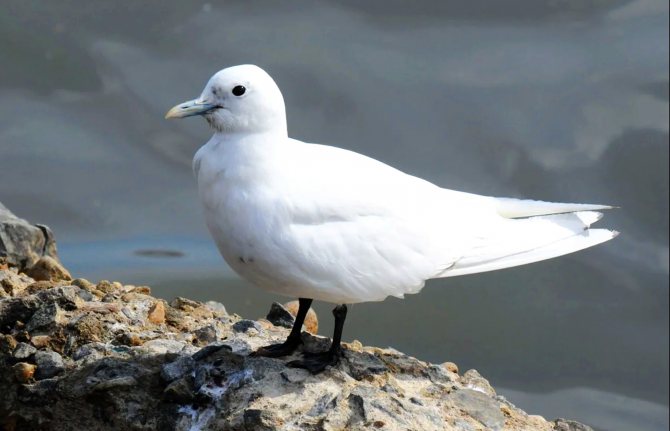
White seagull
Possible factors negatively affecting the population are global warming, illegal hunting, unfavorable environmental conditions. The diet of seagulls consists of crustaceans and fish.
Black-throated Loon
The black-throated loon is a member of the loon genus. Birds live in the northern part of Russia. They prefer to build nests in reservoirs, as well as in the tundra zone. Lately, loons have noticeably moved north.
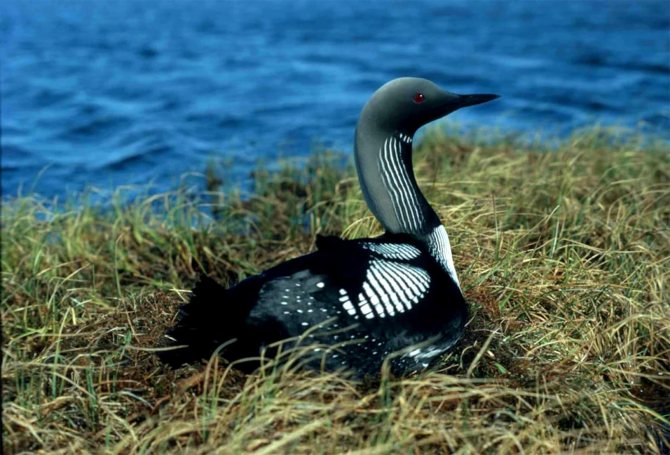
Black-throated Loon
This was influenced by human activity - fishing and actively developing tourism in the coastal zone. The increase in the number of birds is hampered by predators that actively hunt for their eggs. Loons are also often caught in fishing nets.


